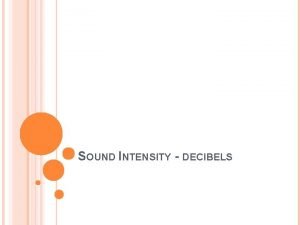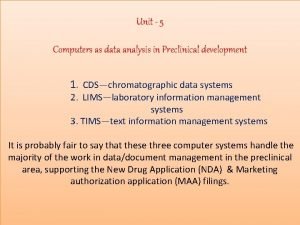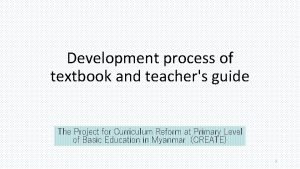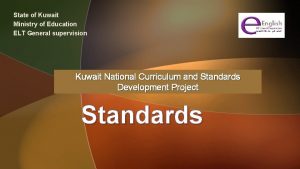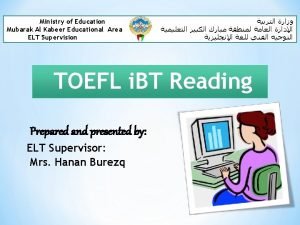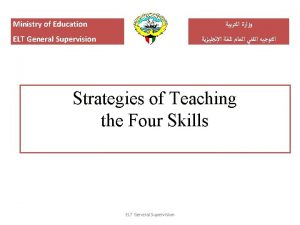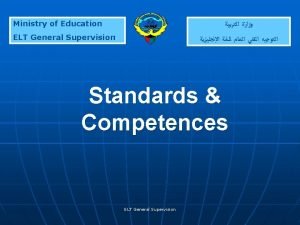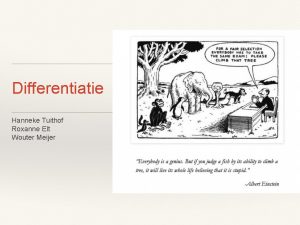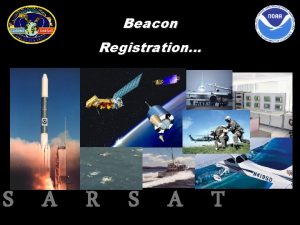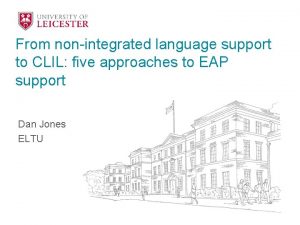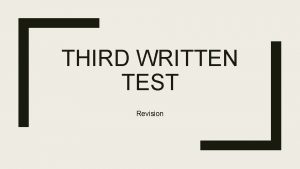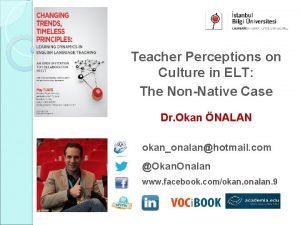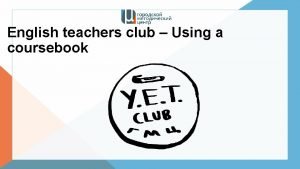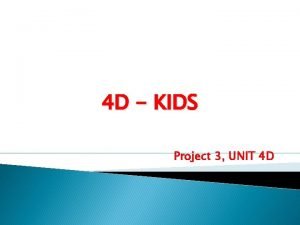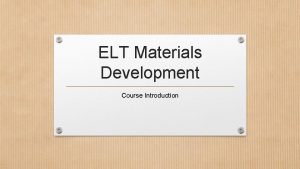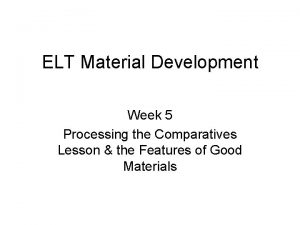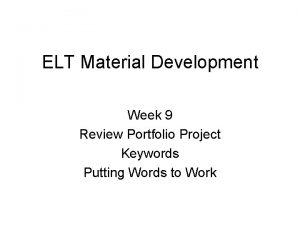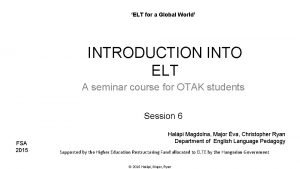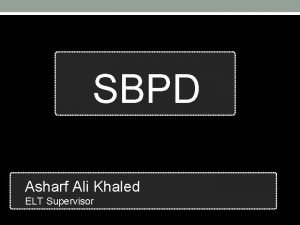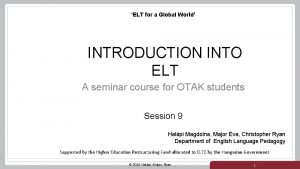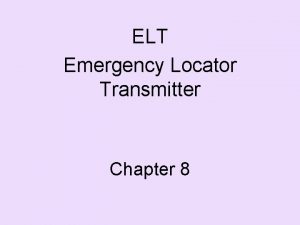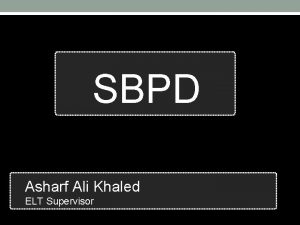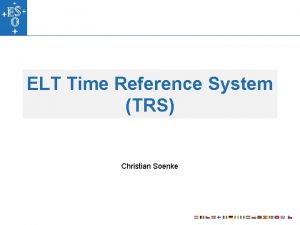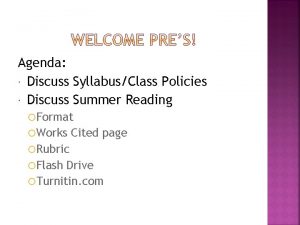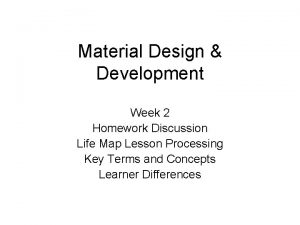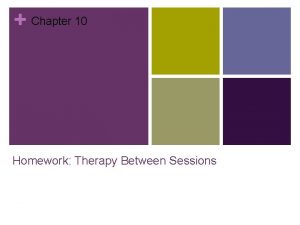ELT Material Development Week 3 Discuss Reading Homework




































- Slides: 36

ELT Material Development Week 3 Discuss Reading Homework Features of Good Materials

Housekeeping: Name Cards Name: _________ English Nickname: _____ Email address: _______ Phone #: _________ Something about your self: ____________________ Your Picture

Homework for Next Week • Read answer the questions to Grave’s “Adapting Coursebooks” • Questions p. 32. Reading pages 33 -56. Homework Discussion • Discuss your answers to the Qs from p. 15 about The Introduction to Materials Development

Kinds of Language Learning Explicit • learners are aware of when and what they are learning Implicit • learners are not aware of when and what they are learning Involving Declarative Knowledge • knowledge about the language system Involving Procedural Knowledge • knowledge of how the language is used

• What is the position that most researchers take in terms of the kinds of language learning? • Communicative competence is primarily achieved as a result of implicit, procedural learning.

• What should the main objective of materials be? • To provide learners with meaningful experiences of language in use and opportunities to reflect on these experiences.

• When are learners guided to see explicit aspects of the target language? • Prior to students’ use • After students’ use • *NOTE: both can be done inductively so the teacher can facilitate students’ discovery of rules.

In-class group activity • Look through the sixteen features of good materials pp. 30 -31. • Can you think of an example? • Discuss with your group members and identify which features are still unclear.

1. 2. 3. 4. 5. 6. 7. 8. 9. 10. 11. 12. 13. 14. 15. 16. Materials should achieve impact Materials should help learners to feel at ease Materials should help learners develop confidence What is being taught should be perceived as relevant and useful Materials should facilitate learner self-investment and discovery Learners must be ready to acquire the points being taught Materials should expose the learners to language in authentic use Learner’s attention should be drawn to the linguistic features of the input Materials should provided opportunities to use the TL for communicative purposes Materials should take into account that the positive effects of instruction are usually delayed Materials should take into account that learners have different learning styles Materials should take into account that learners differ in affective attitude Materials should permit a silent period at the beginning of instruction Materials should maximize learning potential Materials should not rely too much on controlled practice Materials should provide opportunities for outcome feedback

1. Materials should achieve impact

2. Materials should help learners to feel at ease • Things that a material developer can do to make Ss feel at ease: ’ – – – – • lots of white space illustrations that learners can relate to balance Ss academic and emotional needs, so…. materials seem helpful rather than test like materials that have a humane personality and voice rather than semiofficial documents that one might find at a government office use active voice rather than passive examples and stories that make it seem more real; concrete and connect to the Ss lives and social context Language should be inclusive It’s the learner’s language, too! How material developers/Ts use of the target language shouldn’t make Ss feel inferior; the level and the way the TL is ‘used’ should neither demean nor patronize

Build rapport by sharing aspects of yourself

3. Materials should help learners develop confidence • • Challenge level (i+1). Staging and task sequencing Removing scaffolding and support language Success builds success and success = confidence

4. What is being taught should be perceived as relevant and useful • Find out what your Ss like and want to learn through needs analysis • Make task and activities “real” & “meaningful” • Allow for Ss personalization of learning • Use games, contest and competitions to create materials that have the perception of relevance

5. Materials should facilitate learner self-investment and discovery • • • Learning situations are created in which the learning is often implicit Inductive methods are used Learner-centered, task-based, learn by doing Ss-Ss collaboration and peer learning maximized Teacher Talk Time (TTT) minimized Teacher’s don’t teach; students learn

• Classroom that facilitate learner self-investment and discovery often look like this. • Where’s the teacher? • Present, but not directly involved.

6. Learners must be ready to acquire the points being taught • • • Materials are developed so Ts can easily do initial and ongoing assessment Materials are created with the understanding that Ss learn at different rates, and not all Ss are necessarily ready to acquire what is being taught Developmental sequence is taken into account

Developmental Sequence • The terms above refers to the passage of learners through a series (of in most cases) progressively more accurate manifestations of a given feature such as negation, question-forms, etc…The developmental sequence for L 2 learners is very similar to the developmental sequence for L 1 learners of English.

7. Materials should expose the learners to language in authentic use • • Authentic Input: listening and reading texts created by native speakers for native speakers Authentic Output: Tasks and activities that have a real context of use

8. Learner’s attention should be drawn to the linguistic features of the input • • • Meaning before form Materials help Ss to notice gap in interlanguage Recycling of key points or features to assure that Ss notice and acquire Use enhanced input techniques to drawn Ss attn to salient features of input Schema activation

Enhanced Input • • • Jane plans to marry Tom. She likes Tom, but Tom doesn’t like her. Tom always runs when he sees her. She catches Tom falls in love. It ends happily. What do I want my Ss to notice? How is their attention drawn to the input?

Schema Theory & Schema Activation

Preparing Ss to learn new vocabulary and concepts

9. Materials should provided opportunities to use the TL for communicative purposes • • • Information and opinion gaps Survey Mingle activities

10. Materials should take into account that the positive effects of instruction are usually delayed • Language awareness usually comes before language use; that is, learners become aware of concepts, structures and vocabulary and can understand them before they can use them productively and consistently on their own.

11. Materials should take into account that learners have different learning styles • • Global vs. Analytic Visual, Auditory, Kinesthetic and Tactile (VAKT) Intra-personal vs. Inter-personal There are many more

12. Materials should take into account that learners differ in affective attitude • • balancing academic and emotional needs providing learners with choices remembering variety is the spice of life including opportunities for Ss to discuss… – – • • • the value of learning English their attitudes and feeling about the course and materials being aware of the cultural sensitivity of your learners giving Ss opportunities to connect classroom themes and topics to their own lives and experiences providing roles for reluctant learners who do not want to participate in group work

13. Materials should permit a silent period at the beginning of instruction • • • Use routines like think, pair, share Allow learners to plan and reflect before they speak Use TPR or other techniques to assess learner understanding before speaking

14. Materials should maximize learning potential Left Brain • uses logic • detail oriented • facts rule • words and language • present and past • math and science • can comprehend • Knowing • Acknowledges • order/pattern perception • knows object name Right Brain • uses feeling • "big picture" oriented • imagination rules • symbols and images • present and future • philosophy & religion • can "get it" (i. e. meaning) • believes • appreciates • spatial perception • knows object function

15. Materials should not rely too much on controlled practice • If you walk into a middle school classroom and say to the class: “Hello, how are you? ” How will the class answer?

16. Materials should provide opportunities for outcome feedback • • • Puzzles Classification and categorization activities Peer directed tasks that allow Ss to compare their drawing, pictures or answers

How Do Learners Differ? • • Age Level Aptitude (Multiple Intelligences) Background Experiences Personality Learning Styles Beliefs and attitudes Motivation

Age • Young Learners • Adolescents/Middle School • Adults What are the significant traits or characteristics of each group?

Young Learners • Respond to meaning even if they don’t understand individual words. • Learn more indirectly than directly. (Implicit) • Understanding comes from what they see, hear, touch and interact with, not just from explanation. • Generally display an enthusiasm for learning and are curious about the world around them. (Learn through discovery) • Have a need for individual attention and approval from the teacher. • Keen to talk about themselves and respond well to learning that uses their own lives as topics in the classroom (personalization). • Have limited attention span unless the activity is extremely engaging.

Adolescents • Is a time of rapid physical growth (puberty) – Puberty affects their energy levels, attention span, and cognitive development • Are emotional and moody, but also want to feel independent and mature • Are more aware of their relation to their peer group and so prefer not to need the teacher’s help or approval • Needs learning to be meaningful in terms of what they perceive or believe is cool and popular • Their ability to think abstractly increases, that is they move from an ego-centric learner to more mature and contemplative learner • Are more concerned with the here and now and less worried about the future, so motivational strategies must reflect this

Adults • Are more autonomous and self directed • Have a wide range of experiences and knowledge to draw on • Are goal and future oriented • Are slower to learn something, but learn it more deeply
 Week by week plans for documenting children's development
Week by week plans for documenting children's development Amateurs discuss tactics professionals discuss logistics
Amateurs discuss tactics professionals discuss logistics Pre reading while reading and post reading activities
Pre reading while reading and post reading activities Week 16 homework: penetration testing 1
Week 16 homework: penetration testing 1 Fill in the blank. you finish your homework today?
Fill in the blank. you finish your homework today? Last week's homework
Last week's homework Last week's homework
Last week's homework Homework oh homework
Homework oh homework Homework oh homework i hate you you stink
Homework oh homework i hate you you stink Jack prelutsky homework oh homework
Jack prelutsky homework oh homework Oh homework oh homework poem
Oh homework oh homework poem Alitteration definition
Alitteration definition Consonance
Consonance Reading homework ideas
Reading homework ideas Explain the steps in portfolio management
Explain the steps in portfolio management What is the role of computer in preclinical development mcq
What is the role of computer in preclinical development mcq Discuss textbook development process
Discuss textbook development process Elt supervision
Elt supervision Repak elt members
Repak elt members Mubarak elt
Mubarak elt Eltsupervision
Eltsupervision English supervision kuwait
English supervision kuwait Direct method is also called
Direct method is also called Elt supervision
Elt supervision Roxanne elt
Roxanne elt Noaa sarsat beacon registration
Noaa sarsat beacon registration Clipping definition in linguistics
Clipping definition in linguistics Elt supervision
Elt supervision Elt
Elt Elt oup student headway
Elt oup student headway Okan önalan
Okan önalan English teachers club
English teachers club Oxford project 3 unit 4 test
Oxford project 3 unit 4 test Gdt symbol
Gdt symbol Time variance
Time variance What is cultural relativism
What is cultural relativism What is real culture
What is real culture





